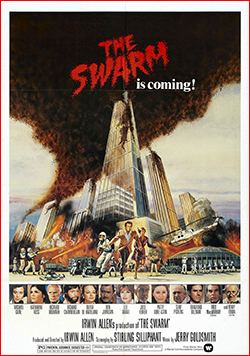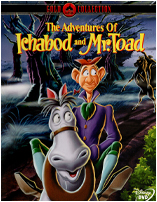 With titles such as Invasion of the Bee Girls (1973), Killer Bees (1974), The Savage Bees (1976), The Bees (1978) and Terror Out of the Sky (1978), we can fairly say that the 1970s was also the decade of the killer bees. While most of them were obscure TV movies, it was The Swarm that stood out, mainly because this was a big Hollywood studio film with as many Oscar winners as possible on the cast list, fronted by Michael Caine. And before Roland Emmerich and his Independence Day, which revived the disaster-film genre in the mid 90s, there was Irwin Allen. “Master of Disaster“ he was called in positive terms for the success of producing blockbusters like The Poseidon Adventure (1972) and The Towering Inferno (1974) which is regarded as the very first disaster-film. He also directed numerous TV series. So, in 1978, it was time to not only to produce, but also direct his first disaster feature with a big star cast and the most notable of all: 20 million bees!
With titles such as Invasion of the Bee Girls (1973), Killer Bees (1974), The Savage Bees (1976), The Bees (1978) and Terror Out of the Sky (1978), we can fairly say that the 1970s was also the decade of the killer bees. While most of them were obscure TV movies, it was The Swarm that stood out, mainly because this was a big Hollywood studio film with as many Oscar winners as possible on the cast list, fronted by Michael Caine. And before Roland Emmerich and his Independence Day, which revived the disaster-film genre in the mid 90s, there was Irwin Allen. “Master of Disaster“ he was called in positive terms for the success of producing blockbusters like The Poseidon Adventure (1972) and The Towering Inferno (1974) which is regarded as the very first disaster-film. He also directed numerous TV series. So, in 1978, it was time to not only to produce, but also direct his first disaster feature with a big star cast and the most notable of all: 20 million bees!
The plot centers around Texas where a large legion of African killer bees have invaded the state. While the bees spread further into the country and starts terrorizing cities and leaving thousands of body counts, the scientist Dr. Bradford Crane (Michael Caine) is constantly on track to figure out a plan to stop them while fighting against the government. With him he has his trustworthy Dr. Walter Krim (Henry Fonda) to develop an antidote to the bee venom. We quickly learn that these bees are not to be underestimated as they’re capable of attacking military helicopters and plunging them to the ground in an explosion. A sight you don’t see everyday. So yeah, these bees are pissed as hell. We have a picnic scene where a young boy witnesses his parents getting swarmed right before his eyes. He isolates himself in the car, wipes the thick layer of bees on the front windshield and manages to escape by driving off to the nearest town. He later makes matters worse by going back to the area with some friends to throw molotovs at the swarm. It all escalates to the point where cities have to evacuate, which also leads to an infamous scene with a train and a chaotic climax with doomsday mayhem which includes flamethrowers and explosions.
And the question is: is this really as bad as its reputation, even being on the list of “worst films ever made“? Nah. On the technical aspects, the film is, for the most part, pretty solid although it has its stains. The script, however, and if not the pacing of its runtime of 156 minutes (judging Warner Archive’s Blu-ray), has a lot of issues. We have boring subplots with love affairs that go nowhere. Some people come and go and are never to be seen again. There’s some eye-rolling and wonky dialogue here as well, some of which are delivered as if this was an Adam West Batman movie. There’s a bunch of dry science talk, a lot of filler-scenes, which makes the film look more dated, clunky and overall an unfocused mess. The scenes where the stung victims hallucinate and see a big bee hoovering right in front of them looks just goofy, out-of-place and -again- dated like a public-domain 50s monster movie, while the film takes itself dead seriously. Not a masterpiece in any shape or form, but the bees alone makes it worth a watch.
Then we have Michael Caine’s character, who comes across like a stone-cold psychopath who would fit more as a sinister villain in a James Bond film. He always bears a duper-delight and smirks in the most inappropriate moments. His off-putting demeanor may be linked with the fact that this was one of Caine’s notorious list of “paycheck movies“ and he later claimed that it was the worst film he ever starred in. A-ha… He never saw Jaws: The Revenge, another paycheck, so that film doesn’t count. Sir Caine turned 90 recently, by the way. Cheers.
But the real stars of the film is the 20 million bees that got used and sacrificed. God bless and no wonder why they’re furious. Today all would be CGI, no question about it, but here we actually have sets with thousand of bees that swarms around actors and crew as they do their best to not have their mouth open. While there are some dated edges here, the scenes with the bee attacks looks as real as they can get and are quite spectacular, highly ambitiously made and is an unnerving sight. Even though 800,000 of them got their stingers removed, they couldn’t avoid to mix them with those who had the stingers intact which caused several actors to get stung. How anyone would sign up for something like this is beyond me. And the amount of children that’s involved must have parents that really hates them. We always hear about difficult filming conditions, especially from the pre-CGI era where most of the effects had to be shot on set but bruh… I refuse to believe that anyone involved would look back and say; yeah, being in that bee movie was such a fun time and I would do that again. You couldn’t even pay me a million. Mr. Not-The-Bees himself would agree (that meme just had to be shoved in here).
The Swarm was a massive flop and was ridiculed by the few critics that saw it. Producer and director Irwin Allen was so devastated by all the money he lost on the film that he refused to ever mention the film in future interviews. And besides the short 22-minutes making-of documentary on the Blu-ray there isn’t much insight to behold. At least the trivia section on IMDb can tell us that actor Michael Caine stated in an interview that during filming he thought the little yellow spots left by the bees on his clothing was honey, so he began to eat them, entirely unaware that what he was eating was actually bee feces. In other words: honey and bee poop tastes the same. Yummy.



Director: Irwin Allen
Writers: Arthur Herzog III, Stirling Silliphant
Country & year: USA, 1978
Actors: Michael Caine, Katharine Ross, Richard Widmark, Richard Chamberlain, Olivia de Havilland, Ben Johnson, Lee Grant, José Ferrer, Patty Duke, Henry Fonda & 20 million bees
IMDb: www.imdb.com/title/tt0078350/
![]()





















